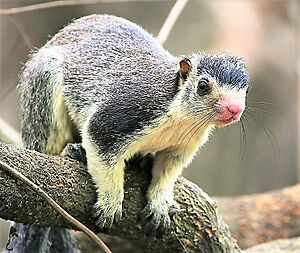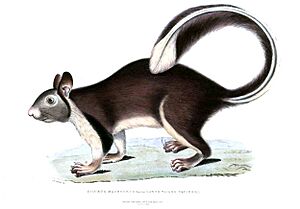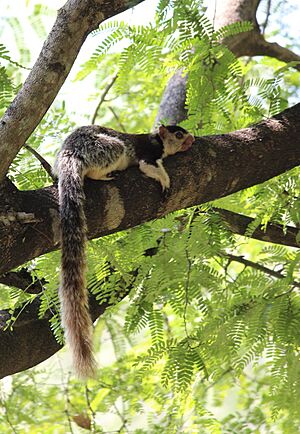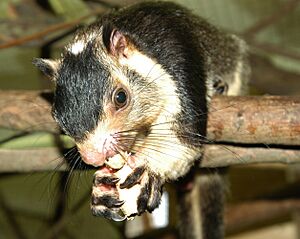Grizzled giant squirrel facts for kids
Quick facts for kids Grizzled giant squirrel |
|
|---|---|
 |
|
| The highland subspecies | |
| Conservation status | |
| Scientific classification | |
| Genus: |
Ratufa
|
| Species: |
macroura
|
| Subspecies | |
|
|
 |
|
| Grizzled giant squirrel range | |
| Synonyms | |
|
Ratufa macroura Phillips, 1931 subspecies sinhala |
|
The grizzled giant squirrel (Ratufa macroura) is a very large tree squirrel. It lives high up in the trees in parts of Sri Lanka and southern India. You can find it in the highlands of Sri Lanka and in riparian forests (forests near rivers) and hill forests in India.
The IUCN says this squirrel is "near threatened". This means it could become endangered soon. The main reasons are habitat loss (its home disappearing) and hunting.
Contents
What's in a Name?
Grizzled giant squirrels get their name from their fur. They have white flecks of hair mixed with their greyish-brown fur. This gives them a "grizzled" or speckled look.
Meet the Grizzled Giant Squirrel
The grizzled giant squirrel is the smallest of the giant squirrels in India. Its head and body are about 25 to 45 centimeters (10 to 18 inches) long. Its tail is usually the same length or even longer. This means a squirrel can be 50 to 90 centimeters (20 to 35 inches) long in total!
These squirrels have small, round ears with pointy tufts of fur. Each squirrel usually roams an area between 1,970 and 6,110 square meters (21,200 to 65,800 square feet).
Squirrel Appearance: Subspecies Differences
There are different types, or subspecies, of the grizzled giant squirrel.
- The dandolena subspecies has brown fur mixed with white on its back. Its belly is light brownish-cream. Its tail looks frosted with white fur. Its forehead and feet are black.
- The melamochra subspecies has jet-black fur on its upper parts. This contrasts with its brownish-cream or orange-yellow belly. Its tail looks frosted with black fur. Both subspecies have pink snouts.
Senses and Sounds
Grizzled giant squirrels have excellent eyesight. This helps them spot predators like eagles or snakes. However, their hearing is not very good.
They make a loud, sharp call that sounds like a repeated cackle. You can often hear this call in the morning and evening. They also use a soft "churr" sound to talk to other squirrels nearby.
Hands and Feet for Tree Life
These squirrels have five fingers on each hand, but one thumb is very small. Their fingers have large, soft pads that help them grip branches. The inner pad is extra wide for better holding.
Their feet also have soft pads. Both their front and back limbs have long, sharp claws. These claws are perfect for climbing and moving quickly through trees.
Where Do Grizzled Giant Squirrels Live?
In India, you can find these squirrels in several places. These include the Grizzled Squirrel Wildlife Sanctuary and the Chinnar Wildlife Sanctuary. They also live in the Palni Hills and the Cauvery Wildlife Sanctuary.
The easternmost group of the Ratufa macroura dandolena subspecies was found in the Pakkamalai Reserve Forest in eastern Tamil Nadu.
The Grizzled Squirrel Wildlife Sanctuary is a special protected area. It is located in Shenbagathoppu, Srivilliputtur, in Tamil Nadu, India.
What Do Grizzled Giant Squirrels Eat?
Grizzled giant squirrels have a varied diet. They eat fruits, nuts, and even insects. They also enjoy bird eggs and the bark of some trees.
A very important food for them is the fruit of a climbing plant called Combretum ovalifolium. Young squirrels, when they first leave their nest, often eat only this fruit.
How Do Grizzled Giant Squirrels Behave?
Unlike some other squirrels, the grizzled giant squirrel uses its two back feet to balance. It doesn't use its tail for balance as much.
These squirrels almost always stay in the trees. They rarely come down to the ground. They might only come down to escape from predators, chase away other squirrels, or find a mate.
Types of Grizzled Giant Squirrels
There are three main types, or subspecies, of the grizzled giant squirrel. You can easily tell them apart by their colors. They also live in different areas.
According to the book Mammals of Sri Lanka, the three subspecies are:
Ratufa macroura macroura
Male squirrels of this type are about 35 cm (14 inches) long, and females are 37 cm (15 inches). Their tails are about 37 cm (14.5 inches) for males and 38 cm (15 inches) for females. Their backs are jet black and shiny. Their rump (lower back) has a white grizzled look. Their bellies are brownish-cream to pale yellow. Their tails are dark black with a white tip. The bare skin on their faces is pink. Their fur is medium length and a bit coarse. This subspecies lives in the central highlands of Sri Lanka, up to 2,000 meters (6,500 feet) high, like in Horton Plains.
Ratufa macroura dandolena
Males of this type are about 37 cm (14.5 inches) long, and females are 35 cm (14 inches). Their tails vary from 37 cm (14.5 inches) for males to 40 cm (16 inches) for females. Males are usually larger than females. Their backs are brown, not jet black like the macroura subspecies. They have a white rump. There's a clear maroon color between their shoulders. They also have a brownish-cream patch on their head. Their bellies are light brownish-cream. Their tails are dark brown with a reddish-brown tip. The bare skin on their faces is pink. Their fur is medium length and coarse. This subspecies lives in the dry parts of Sri Lanka and also in India.
Ratufa macroura melanochra
Males of this type are about 35 cm (14 inches) long, and females are 37 cm (15 inches). Their tails vary from 37 cm (14.5 inches) for males to 38 cm (15 inches) for females. Their upper parts are jet black. This color strongly contrasts with their creamy yellowish bellies. Their fur is shorter and coarser. This subspecies is found in the low country wet zone and intermediate zones of Sri Lanka.
| Subspecies | Authority |
|---|---|
| R. m. macroura | Pennant (1769) |
| R. m. dandolena | Thomas and Wroughton (1915) |
| R. m. melanochra | Thomas and Wroughton (1915) |







